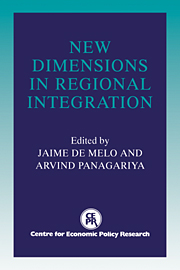Book contents
- Frontmatter
- Contents
- List of figures
- List of tables
- Preface
- Foreword
- Acknowledgements
- List of conference participants
- PART ONE SYSTEMIC ISSUES
- PART TWO COUNTRY ISSUES
- 6 The new regionalism: a country perspective
- Discussion
- 7 The European Community: a case of successful integration?
- Discussion
- 8 Regional integration in Sub-Saharan Africa: past experience and future prospects
- Discussion
- 9 Latin America's integration and the multilateral trading system
- Discussion
- 10 Regional integration in Eastern Europe: prospects for integration within the region and with the European Community
- Discussion
- 11 Regional trade arrangements in North America: CUSTA and NAFTA
- Discussion
- 12 Trading blocs and East Asia
- Discussion
- 13 Prospects for regional integration in the Middle East
- Discussion
- Round Table Discussion
- Index
11 - Regional trade arrangements in North America: CUSTA and NAFTA
Published online by Cambridge University Press: 04 May 2010
- Frontmatter
- Contents
- List of figures
- List of tables
- Preface
- Foreword
- Acknowledgements
- List of conference participants
- PART ONE SYSTEMIC ISSUES
- PART TWO COUNTRY ISSUES
- 6 The new regionalism: a country perspective
- Discussion
- 7 The European Community: a case of successful integration?
- Discussion
- 8 Regional integration in Sub-Saharan Africa: past experience and future prospects
- Discussion
- 9 Latin America's integration and the multilateral trading system
- Discussion
- 10 Regional integration in Eastern Europe: prospects for integration within the region and with the European Community
- Discussion
- 11 Regional trade arrangements in North America: CUSTA and NAFTA
- Discussion
- 12 Trading blocs and East Asia
- Discussion
- 13 Prospects for regional integration in the Middle East
- Discussion
- Round Table Discussion
- Index
Summary
Introduction
Since the mid-1980s, both the profile of and the depth of the debate over regional trade arrangements in North America have grown, first with the 1988 Canada–US Free-Trade Agreement (CUSTA), and subsequently with negotiations in the early 1990s between Mexico, Canada and the United States aimed at achieving a three-country North American Free-Trade Agreement (NAFTA). Recently, debate has intensified even further following a wave of proposed Latin and Central American trade arrangements whose objective, in part, is eventually to facilitate an even wider Western Hemispheric Trade Arrangement (WHFTA). These developments are, however, only part of a global trend towards more extensive regional arrangements in the trading system in the 1990s. In Europe it is manifest in the ‘Europe 1992’ programme, the EC–EFTA pact and other developments; and in Asia it strengthened ASEAN arrangements (AFTA), Australia–New Zealand agreements, and new Japanese regional arrangements.
As elsewhere, the new regional arrangements in North America are driven by a number of factors. A key one is the search for safe-haven trade agreements by smaller countries who now, more than ever before, wish to secure access to the markets of large neighbouring trading partners because of the fear of higher trade barriers in the future. Another is both the frustration felt by larger countries with progress toward new multilateral liberalisation, and their belief that threatening to negotiate, or actually negotiating, regional arrangements on their part may force other reluctant larger powers to make concessions multilaterally.
- Type
- Chapter
- Information
- New Dimensions in Regional Integration , pp. 352 - 382Publisher: Cambridge University PressPrint publication year: 1993
- 5
- Cited by



